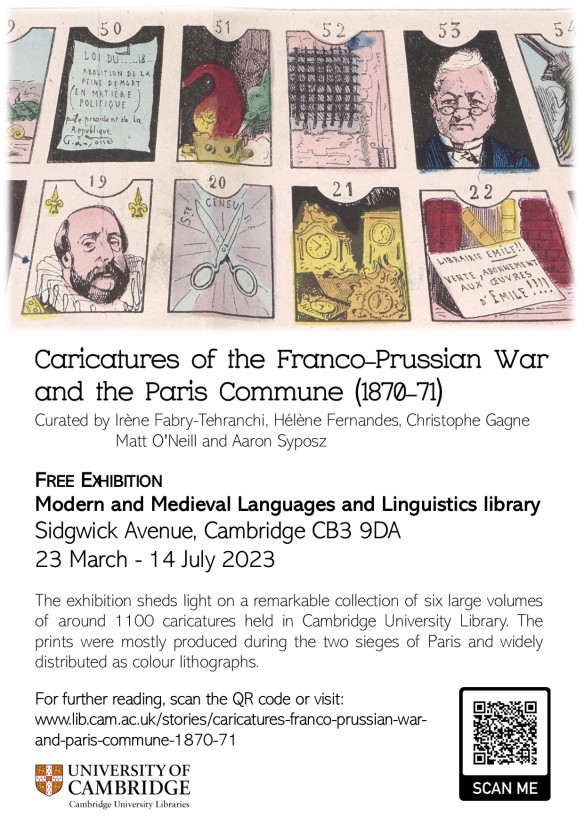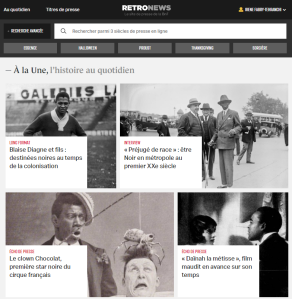The University Library has recently received a donation of several hundred books from the library of the late Professor Trevor Dadson (1947-2020). He was a British Hispanist whose expertise in Golden Age Spanish literature and history gained him worldwide recognition.
Continue reading “The Prof. Trevor Dadson donation on early modern literature, history and culture from Spain”Category: Historical collections
Hebrew and Yiddish books from Odesa
Odesa’s wonderful literary museum was damaged this week in one of Russia’s terrible attacks on the city. The UL has over 200 titles published in Odesa, whose linguistic span alone demonstrates the deep historical and cultural importance of a city which used to hold a special place in the heart of Russians too. Ukrainian and Russian are the main languages represented, but this post looks at one example each in Hebrew and Yiddish, both published when the city had one of the highest Jewish populations in the world.
“Liberté… J’écris ton nom”: Eluard’s poem and the Cambridge UL Liberation collection
The police killing of 17-year-old Nahel Merzouk on 27 June in Nanterre (in the suburbs of Paris) and civil unrest that occurred subsequently in France show how challenging it is to uphold the values of equality and fraternity, both socially and institutionally. For Bastille Day this 14th of July, we focus on the famous poem ‘Liberté’, initially entitled ‘Une seule pensée’, composed by Charles Eluard under the German occupation of France in 1941. This love poem to Nusch was turned into a celebration of and aspiration to Freedom. It is marked by the leitmotiv “J’écris ton nom”, reminding us of the power of both speech and writing. While the collaborationist Vichy régime had replaced the French revolutionary motto from “Liberté, Egalité, Fraternité” to the conservative “Travail, Famille, Patrie”, the poem “Liberté” became emblematic of French resilience throughout the Second World War and beyond. This blogpost gives an overview of the early publications of the poem: many of which are available at Cambridge University Library, including special editions with the Eluard’s signature and dedications, within the Chadwyck-Healey Liberation collection.
Karl Friedrich Schinkel: more than Berlin’s architect

Karl Friedrich Schinkel (1781-1841) was a pre-eminent contributor to the 19th century planning of the city of Berlin, and several of the imposing buildings that he designed can still be admired today in the centre of the city – for instance, the Konzerthaus, the Neue Wache and the Altes Museum. It is now 200 years since he started work on his plans for this museum, the first of several to make up the Museum Island complex. Like many, I knew of him as an architect so I was surprised when I saw a simple chair, perhaps designed by him, during a pre-pandemic visit to Berlin’s splendid Kunstgewerbemuseum. This inspired me to look beyond his architecture and so this blog post will explore non-architectural aspects of his work and feature items from the University Library’s collections. Continue reading “Karl Friedrich Schinkel: more than Berlin’s architect”
Wenceslaus Hollar, a prolific printmaker
In the week leading up to the coronation of King Charles III we look back more than 350 years to the coronation of Charles II, celebrated in John Ogilby’s 1662 The entertainment of his most excellent majestie Charles II, in his passage through the city of London to his coronation. Etchings of the royal cavalcade and of the ceremony in Westminster Abbey were provided by Wenceslaus Hollar. Click on the images below to see larger versions:
A new exhibition of 1870-71 caricatures at Cambridge Modern and Medieval Languages and Linguistics library
A few weeks ago, we opened a new exhibition in the Modern and Medieval Languages and Linguistics library, relating to a collection of 1870-71 caricatures held in the University Library. This project was highly collaborative, involving librarians, academic staff and students. It followed an exhibition held at the UL last year and started with translations of the text and legends of French caricatures into English.
Mennonites and their many migrations
One winner (best adapted screenplay) in the 2023 Oscars is Women talking, a film adaptation of the novel by the Canadian author Miriam Toews, a fictional response to real events that took place in a Mennonite community in Bolivia. When I first heard about this it prompted me to look into the history of the Mennonites. I was fascinated by the numerous moves groups of them had made during the last 500 years. This blog post will look at some of the main migrations during that time and also consider the Mennonites’ Low German dialect, Plautdietsch, which they have preserved across the world. The UL has a huge number of resources, both print and online, on the Mennonites, showing that their beliefs, culture and language are of great interest to researchers.

The name Mennonite was used to refer to Dutch Anabaptists (there were others in Switzerland and Germany) and was derived from Menno Simons, a Catholic priest who turned away from Catholicism and became a leader of the Anabaptist movement in the Low Countries during the time of the Reformation (Anabaptist simply means “one who is baptised again”, referring to the belief that baptism of infants was wrong and that only adults who could knowingly profess their faith should be baptised). Mennonites in the Netherlands were regarded as heretics and were suppressed and persecuted not just by the prevailing Catholics but also by other Protestants. Continue reading “Mennonites and their many migrations”
Dating Spanish chapbooks: preliminary findings of a Digital Humanities project
The one-year project Spanish chapbooks 1700-1900 in CUDL: dating ephemeral literature, made possible by a Cambridge Humanities Research Grant (CHRG) with the support of Cambridge Digital Humanities, has come to an end (see our earlier blog post on the project here).
Continue reading “Dating Spanish chapbooks: preliminary findings of a Digital Humanities project”Cambridge University Library’s trial of RetroNews (French historical newspapers database)
Cambridge University Libraries just started a one-month trial of RetroNews, a database from the Bibliothèque nationale de France, which provides access to about 2000 (primarily French) newspaper titles published between 1631 and 1950. Part of its content is available only by subscription, in contrast to the BnF’s freely accessible material on its digital library Gallica (only 150 of the 2000 RetroNews titles are also available on Gallica).
The subscription to RetroNews offers advanced access to the digitised periodicals and advanced search functions, in particular the option to download results in pdf or text format. It should also be possible to extract search results in csv or xls format; and to request the extraction of text and metadata of a specific search. RetroNews provides access to 4000 items of new editorial content produced by academics and journalists, including articles, interviews, videos, and podcasts / readings of the newspaper pieces by professional actors. Continue reading “Cambridge University Library’s trial of RetroNews (French historical newspapers database)”
Prinzhorn’s influential book, 100 years on
 The idea for this blog post came to me in 2021 when I read a review of an engaging new book, Charlie English’s The gallery of miracles and madness (e-Legal Deposit) in which I first learnt of Hans Prinzhorn’s Bildnerei der Geisteskranken (S400:05.b.9.337). This groundbreaking book analysed the artwork of disturbed psychiatric patients, with just over half of it devoted to detailed descriptions of ten artists, given pseudonyms to protect the reputation of their families. The book was first published 100 years ago in 1922; the University Library copy is a reprint from 1923, demonstrating the book’s popularity. In his The Discovery of the art of the insane (9000.b.1564) John MacGregor describes Prinzhorn’s work as “an unequaled contribution to the study of the art of the mentally ill.”
The idea for this blog post came to me in 2021 when I read a review of an engaging new book, Charlie English’s The gallery of miracles and madness (e-Legal Deposit) in which I first learnt of Hans Prinzhorn’s Bildnerei der Geisteskranken (S400:05.b.9.337). This groundbreaking book analysed the artwork of disturbed psychiatric patients, with just over half of it devoted to detailed descriptions of ten artists, given pseudonyms to protect the reputation of their families. The book was first published 100 years ago in 1922; the University Library copy is a reprint from 1923, demonstrating the book’s popularity. In his The Discovery of the art of the insane (9000.b.1564) John MacGregor describes Prinzhorn’s work as “an unequaled contribution to the study of the art of the mentally ill.”
Cover and title page of our 1923 edition (click on image to see enlarged): Prinzhorn demanded of his publisher that the cover be black with a runic font
Continue reading “Prinzhorn’s influential book, 100 years on”





















